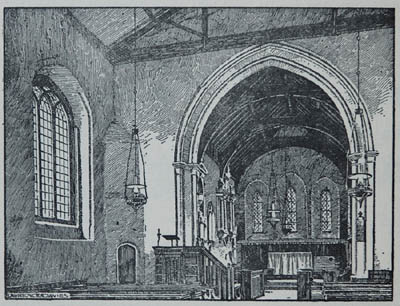A History of the County of Hertfordshire Volume 4 - Layston pages 77 to 88

The tower arch is of 15th-century date of three moulded orders, the outer two continuous, the inner resting on a semi-octagonal shaft with moulded capitals and bases. The west door has a pointed arch of two orders under a square head and moulded label; the cusped spandrels contain blank shields. Above the doorway is a string-course, of which the label forms the lower member, carried along the west face of the tower ; it is carved with leaves at close intervals. Beside the south jamb of the doorway externally are the remains of a stoup, elliptical on plan, with four-centred cinquefoiled arch. Thorley is the only other example in the county of a stoup at the west doorway. The west window has three cinquefoiled lights with tracery under a pointed arch ; on each of the north, south and west sides of the second stage is a narrow loop light. The belfry windows are of two cinquefoiled lights with quatrefoil in the head.
The font is of 15th-century date. The bowl is octagonal with a circular quatrefoiled panel on each face. The octagonal pedestal has traceried panels, in some of which are small shields carved with emblems of the Passion, much worn ; several s hields have disappeared.
hields have disappeared.
The pulpit is made up of panelling of the 16th and 17th centuries; in the front is a linen panel. Most of the seating is of 15th-century date with buttressed ends and moulded rails.
In the north-west angle of the nave is a slab with indents of two men, two women and children. On the north chancel wall is a mural monument of marble and alabaster to John Crouch, 1605, with the arms of himself, his wife and the alliances of his ten children. On the south wall of the nave is a tablet to William Slatholme, Doctor of Physics, 1665.
There are five bells, four of them dated 1633, the fifth by Pack & Chapman, 1776.
The communion plate which is used at St. Peter's chapel of ease in Buntingford consists of silver-gilt cup, 1681, silver-gilt paten and large salver, 1683, The registers before 1812 are as follows ; (i), (ii), (iii), and (iv) baptisms and burials 1563 to 1800, marriages 1563 to 1753 ; (v) baptisms and burials 1801 to 1812 ; (vi) marriages 1754 to 1812.
The chapel of ease, dedicated to ST. PETER, consists of chancel 21 ft. by 13 ft. with apse, nave 39 ft. 6 in, by 21 ft., east and west transepts each 11ft. 6 in. deep by 24 ft, wide, modern vestry and north porch ; all dimensions are internal. The walls are of red brick and the roofs are tiled.
The chapel was built about 1614 by the Rev. Alexander Strange, as is recorded on the brass within the chapel.(48a) It is in the form of a cross with the chancel and apse on the south. In 1899 the building was thoroughly restored, a vestry was erected west of the chancel, a new north porch was added, the walls of the apse were raised and a new roof put on, new brick windows were inserted throughout, the original pews with carved backs were removed and modern seating substituted.
The chancel opens into the semicircular apse by a modern arch of red brick. There is a modern window on the east side. There is no chancel arch.
The nave has modern windows and a modern north doorway and porch. In the west transept is a gallery with plain panelled front, of about 1615, supported on small round wooden columns with Ionic capitals and bases. In the west wall is a doorway with the original four - centred brick arch ; the jambs are of modern brickwork. The windows in both transepts are modern. Over the north gable is a small brick bellcote and in the east gable is a stone inscribed DOMUS ORATIONIS, 1615. All the roofs are modern, but several plain tie-beams of the original roof remain. The pulpit is made up of panels from the old pews, with arabesque carving in the upper panels. Some of the chancel seats also contain old panels, and some have buttressed ends similar to those at Layston Church, from which they probably came. On the south wall of the east transept is a brass engraved with a view of the interior of a small Renaissance chapel during service ; it, however, bears little resemblance to the existing building. The preacher in the pulpit and the congregation are also shown. It is to Alexander Strange, vicar of Layston and builder of the chapel; it bears the date 1620. In the north window is a shield of
48a See also below under advowson.
 | Select page number: Page 86 |  |
